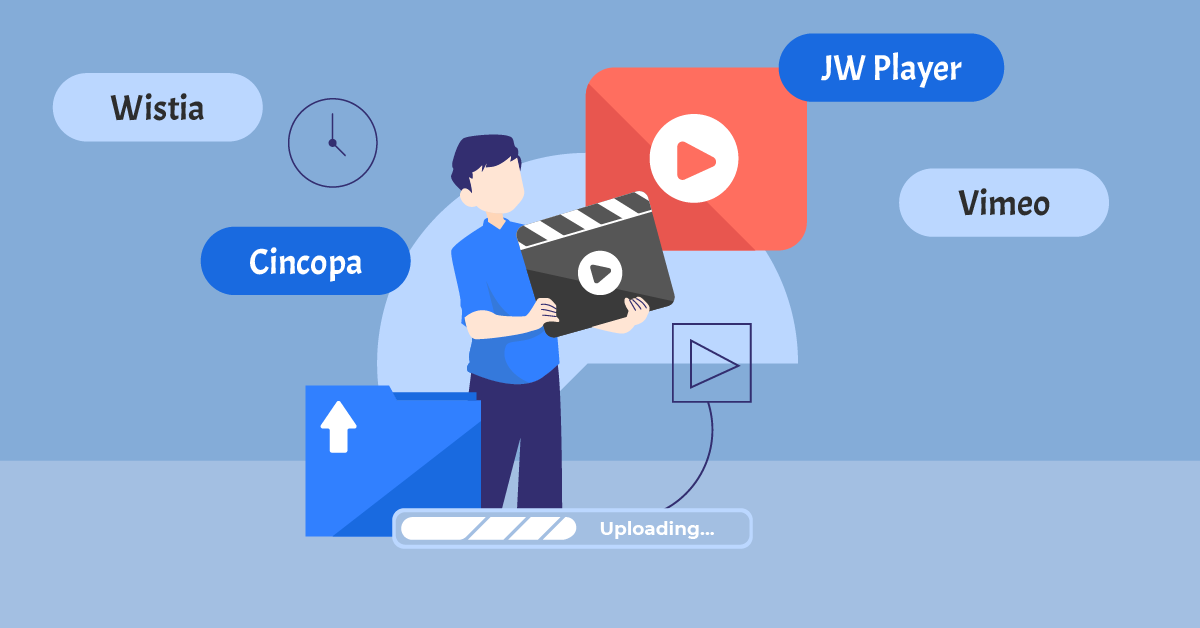
Understanding the Importance of Video Content for Corporate Websites
In today’s digital landscape, the use of video content has become increasingly prevalent in corporate website strategies. This surge can be attributed to the profound impact and numerous benefits that video content offers to businesses. Understanding the significance of incorporating video content into corporate websites is essential for staying competitive and engaging with target audiences effectively.
The Rise of Video Content in Digital Marketing
The prevalence of video content in digital marketing has skyrocketed in recent years. According to survey data, 96% of marketers recognize video as a crucial component of their marketing strategy, highlighting its pivotal role in driving engagement and conversions. Furthermore, an overwhelming 91% of businesses now leverage video as a key marketing tool, signifying the widespread adoption and success of video-based marketing initiatives.
The shift towards video-centric marketing approaches is further underscored by consumer preferences. A staggering 90% of consumers express a desire to see more video content from brands, emphasising the growing demand for visually engaging and informative brand communication.
Benefits of Video Content for Corporate Websites
The integration of video content on corporate websites yields multifaceted benefits that directly contribute to business growth and audience engagement. Statistical data reveals that 86% of marketers attribute increased website traffic to the incorporation of video content, demonstrating its capacity to drive valuable user interactions and prolonged website visits.
Moreover, videos have proven instrumental in enhancing brand awareness among audiences, with 90% of businesses affirming that video marketing has significantly elevated their brand visibility. This aligns with the finding that landing pages featuring optimised corporate videos are 53% more likely to appear on the first page of Google search results, highlighting the SEO advantages associated with video integration.
Additionally, videos have emerged as powerful tools for influencing consumer behaviour and purchasing decisions. An overwhelming 92% of people report being persuaded to buy a product or service after watching a brand’s video, underscoring the persuasive impact that well-crafted video content can have on consumer actions.

The Basics of Video Content Integration
As the digital landscape continues to evolve, the integration of video content has become a fundamental aspect of corporate website strategies. Understanding the basics of video content integration is crucial for businesses aiming to enhance their online presence and engage with their target audiences effectively.
What is Video Content Integration?
Video content integration refers to the seamless incorporation of videos into a website’s existing content framework. It involves strategically embedding videos within web pages to complement textual information, enhance user engagement, and deliver compelling visual narratives. This process extends beyond mere placement, encompassing considerations such as video hosting, playback optimization, and alignment with overall brand messaging.
The foundation of video content integration lies in recognizing the diverse purposes that videos can serve. They can be educational, commercial, explanatory, or entertaining, catering to various audience preferences and informational needs. When used in the context of a case study or product demonstration, videos augment the reader’s experience by breaking up written content with an interactive and moving element.
Moreover, video technology serves as the very foundation of video creation and dissemination. Advancements in video production tools and platforms have empowered businesses to craft high-quality visual content that resonates with their audiences across different digital channels.
Key Components of Successful Video Integration
- Strategic Alignment: Successful video integration hinges on aligning video content with overarching marketing objectives and brand messaging. Videos should seamlessly complement existing textual and visual elements while reinforcing key brand messages.
- Optimised User Experience: Prioritising user experience is paramount in effective video integration. This involves ensuring responsive video playback across devices, intuitive navigation through video libraries or playlists, and minimal loading times for seamless viewing experiences.
- SEO Optimization: Integrating videos with search engine optimization (SEO) best practices enhances discoverability and visibility on search engine results pages (SERPs). This includes optimising video titles, descriptions, tags, and metadata to improve organic search rankings.
- Engagement Analytics: Implementing analytics tools to track user engagement metrics such as watch time, click-through rates, and viewer demographics provides valuable insights for refining future video integration strategies.
Accessibility Considerations: Ensuring that videos are accessible to all users through closed captions, audio descriptions for visually impaired individuals, and compatibility with assistive technologies fosters inclusivity within the digital.

Choosing the Right Platform for Your Video Content
In the realm of corporate websites, selecting the appropriate platform for video content integration is a pivotal decision that directly impacts user experience and content management. An overview of leading video hosting sites and key factors to consider when choosing a platform can guide businesses in making informed decisions tailored to their specific needs.
Overview of Video Hosting Sites
Wistia
Wistia stands out as a business-oriented video hosting platform designed to address the marketing requirements of enterprises. Its feature set encompasses video creation, management, hosting, analytics, and personalization. With a focus on tracking a video’s progress, collecting leads, and maximising return on investment (ROI), Wistia empowers businesses to leverage their video content effectively within their corporate websites.
Cincopa
Cincopa offers a comprehensive multimedia presentation solution by enabling the combination of various media formats into cohesive presentations. Notably, it provides an extensive video analytics toolset, equipping businesses with valuable insights into viewer engagement and interaction patterns. This platform’s versatility in handling diverse media types positions it as a viable option for holistic video content integration strategies.
JW Player
Originally originating as an open-source project, JW Player has evolved into a prominent name among enterprise-level video hosting solutions. Its content management system boasts an array of tools and features geared towards facilitating seamless video content integration. Leveraging a global content delivery network (CDN), robust analytics capabilities, and diverse video monetization options, JW Player caters to the multifaceted needs of corporate websites seeking advanced video management solutions.
Vimeo
Renowned for its widespread user base and intuitive interface, Vimeo serves as an established choice for enterprise-level video hosting, sharing, and streaming. Offering an array of features such as video marketing tools, employee communication resources, and monetization options, Vimeo presents itself as a user-friendly platform conducive to streamlined video content integration within corporate websites.
Factors to Consider When Selecting a Platform
Customization Capabilities
When evaluating potential platforms for video content integration on corporate websites, assessing customization capabilities is paramount. The ability to tailor player designs, embed codes, and interactive elements aligns with the branding requirements of corporate websites seeking seamless visual alignment with their overall aesthetic.
Analytics and Insights
Comprehensive analytics functionalities play a crucial role in understanding audience behaviour and optimising video content performance. Platforms offering detailed metrics on viewer engagement, retention rates, click-through behaviour, and demographic insights empower businesses to refine their video integration strategies, ensuring relevance and resonance with target audiences.
Scalability and Flexibility
Scalability considerations are essential for accommodating evolving business needs and expanding video content libraries over time. Platforms that offer flexible storage options, scalable pricing models based on usage or viewership metrics provide businesses with adaptable solutions capable of growing alongside their digital presence.
Security Measures
Prioritising data security is non-negotiable when integrating videos into corporate websites. Evaluating platforms’ security protocols encompassing encryption standards, access controls, compliance certifications ensures that sensitive company information remains safeguarded against unauthorised access or breaches.

Strategies for Effective Video Content Integration
Incorporating Video into Website Design
The integration of video content into website design plays a pivotal role in enhancing the visual appeal and informational depth of corporate websites. By strategically embedding videos within the layout and structure of web pages, businesses can create a more immersive and engaging user experience. This approach aligns with the growing demand for visually stimulating and informative brand communication, as evidenced by consumer preferences for more video content from brands.
One effective strategy for incorporating video content into website design is to utilise it as a storytelling tool. By integrating educational, commercial, explanatory, or entertaining videos, businesses can augment the reader’s experience and effectively convey their brand narrative. These videos help tell the story of the design method or explain the product in a compelling and visually captivating manner.
Enhancing User Engagement with Interactive Video
Interactive video content serves as a powerful mechanism for elevating user engagement on corporate websites. By leveraging interactive elements such as clickable hotspots, quizzes, or branching narratives within videos, businesses can create an interactive viewing experience that captivates audiences and encourages active participation. This approach not only fosters deeper user engagement but also provides valuable insights into audience preferences and behaviours.
Moreover, interactive video experiences contribute to prolonged website visits and increased time spent on web pages. This directly aligns with the goal of driving more website traffic and keeping visitors engaged through dynamic and interactive video content.
In essence, integrating interactive elements into video content represents an innovative approach to enhancing user engagement while aligning with evolving consumer preferences for immersive digital experiences.

Best Practices for Video Content Integration on Corporate Websites
In the realm of corporate websites, implementing best practices for video content integration is essential to ensure optimal web performance and compliance with accessibility standards. By adhering to industry best practices, businesses can effectively optimise their video content for seamless user experiences and enhanced search engine visibility.
Optimising Video for Web Performance
Optimising video content for web performance encompasses a multifaceted approach aimed at enhancing playback quality, loading speed, and compatibility across various devices and browsers. Detailed insights from web developers and designers emphasise the significance of proper optimization to improve SEO performance and ensure a seamless viewing experience for users.
One crucial aspect of optimising video performance involves leveraging enterprise video hosting platforms that offer services tailored to businesses of all sizes. These platforms provide secure and easily accessible videos while handling essential processes such as encoding, transcoding, and resizing to ensure compatibility with diverse players, browsers, operating systems, and devices.
Furthermore, incorporating well-optimised videos into web pages as part of a comprehensive SEO strategy can elevate content in search engine rankings. This aligns with the evolving preferences of users for visual information, prompting search engines to prioritise video content in their results.
In essence, by prioritising optimization efforts, businesses can enhance their online visibility and user engagement through strategically integrated video content that caters to modern digital consumption habits.
Ensuring Accessibility and Compliance
Ensuring accessibility and compliance with industry standards is paramount when integrating video content into corporate websites. Detailed analytics from business video hosting services provide valuable insights into viewer behaviour, watch time, engagement rates, and conversion metrics. This data serves as a foundation for refining video integration strategies, ensuring relevance and resonance with target audiences while meeting accessibility requirements.
Dedicated video hosting services handle all the optimising necessary to get videos playing properly on smartphones, tablets, and computers. This streamlines the process of displaying videos on websites and online platforms while maintaining compatibility across a wide range of devices.
Moreover, corporate videos must be an essential part of the content marketing strategy, optimised for mobile devices to drive traffic, create content engagement, and educate consumers on social media platforms. By embedding corporate videos on websites and sharing them on social media channels, businesses can increase viewer engagement and time spent on their website while enhancing search engine optimization efforts by appearing in search results.

Creating Compelling Video Content for Corporate Audiences
Crafting compelling video content tailored to corporate audiences requires a deep understanding of the target demographic and an emphasis on delivering engaging and informative visual narratives.
Understanding Your Audience
Before embarking on the creation of video content, it is imperative for businesses to gain comprehensive insights into their target audience. This involves conducting thorough market research, analysing consumer behaviour patterns, and identifying the specific preferences and pain points of the corporate audience. By delving into demographic data, psychographic characteristics, and consumption habits, businesses can tailor their video content to resonate with the unique needs and interests of their corporate clientele.
Bobby Starks, a renowned expert in video production, emphasises the significance of understanding the audience in crafting effective corporate videos. According to Starks, “A corporate video is a great medium to communicate what your brand represents. With the help of an experienced video production team, you’ll be able to prepare a storyboard that is sure to capture the attention of your viewers online.”
This insight underscores the pivotal role of audience comprehension in shaping compelling video content that aligns with brand messaging and resonates with corporate viewers. By leveraging consumer insights, businesses can create videos that address specific pain points, showcase product benefits, or narrate captivating brand stories tailored to their target audience’s preferences.
Crafting Engaging and Informative Videos
The art of crafting compelling video content lies in seamlessly blending engagement with information dissemination. Corporate videos should aim to captivate viewers while delivering valuable insights or narratives that align with business objectives.
One effective approach is storytelling through visual narratives. By weaving together captivating visuals with impactful storytelling elements, businesses can effectively convey their brand story and product benefits in a manner that resonates with corporate audiences. This method not only enhances brand recall but also fosters emotional connections with viewers, driving long-term engagement and loyalty.
Moreover, emphasising educational value within video content contributes to its effectiveness in communicating complex concepts or showcasing product functionalities. Informative videos that provide practical solutions or insights relevant to corporate challenges serve as valuable resources for professionals seeking actionable knowledge within their industry domain.
Starks further highlights the efficacy of using video content for educational purposes by stating, “Consumers absorb information in a video much faster than text as they are easy on your eyes, and there is a higher brand recall.” This assertion underscores the potency of educational videos in conveying information efficiently while leaving a lasting impression on corporate audiences.
In essence, crafting engaging and informative video content entails striking a harmonious balance between captivating storytelling and valuable knowledge dissemination tailored specifically to meet the needs of corporate viewers.

Leveraging Social Media for Video Content Distribution
In the realm of corporate websites, leveraging social media for video content distribution is a strategic imperative that amplifies brand visibility and fosters audience engagement. By harnessing the viral potential of social sharing, businesses can extend their reach, generate buzz around their brand, and cultivate a community of loyal followers.
Integrating Social Media Feeds on Corporate Websites
Integrating social media feeds on corporate websites serves as a dynamic conduit for showcasing video content to visitors while fostering cross-platform engagement. This approach involves embedding live or curated social media feeds directly onto web pages, enabling seamless access to a diverse array of video content shared across social platforms.
The integration of Instagram Reels, TikToks, Facebook ads, shoppable videos, live videos, and webinars into corporate websites offers an immersive viewing experience that aligns with modern consumer preferences. By curating a visually compelling mosaic of user-generated video content alongside branded promotional videos, businesses can create an interactive and captivating digital environment that resonates with visitors.
Moreover, leveraging social media feeds facilitates real-time updates on corporate website pages by dynamically populating them with fresh video content from various social channels. This not only enriches the user experience but also ensures that visitors are consistently exposed to engaging and relevant video narratives that reflect the brand’s dynamic presence across social platforms.
Promoting Corporate Videos on Social Platforms
Promoting corporate videos on social platforms entails crafting compelling video content tailored to resonate with diverse audiences while adhering to platform-specific best practices. Businesses can capitalise on trending topics, leverage user-generated content, or incorporate interactive elements to enhance the viral potential of their corporate videos.
One notable success story in this domain is exemplified by GoPro’s Million Dollar video marketing campaign in 2018. The campaign rewarded creators with $1 million for crafting highlight reels for their Hero7 Black camera series. This initiative garnered 25,000 submissions from 22 countries and amassed over 3 million views across various social media platforms. The campaign not only engaged a broad audience but also exemplified the power of shareable video content in driving brand visibility and audience engagement.
Additionally, businesses can harness the effectiveness of short-form video formats such as Instagram Reels and TikTok to simplify complex information and cater to silent scrolling habits prevalent among modern consumers. These platforms offer an avenue for creating visually captivating videos that resonate with viewers on an emotional level while aligning with evolving trends in digital consumption habits.
In essence, promoting corporate videos on social platforms requires a nuanced understanding of audience preferences and platform dynamics to craft shareable video content that resonates with viewers at an emotional level while aligning with contemporary trends in digital storytelling.

Measuring the Success of Video Content Integration
Measuring the success of video content integration is crucial for businesses to gauge the impact and effectiveness of their video strategies. By analysing key performance indicators (KPIs) and leveraging tools for video performance analysis, organisations can gain valuable insights into the outcomes of their video integration efforts.
Key Performance Indicators (KPIs) for Video Content
When assessing the impact of video content integration, businesses should focus on key performance indicators that reflect various aspects of user engagement, brand visibility, and conversion rates. The following KPIs serve as essential metrics for evaluating the success of video integration strategies:
- Conversion Rate: Tracking changes in conversion rates before and after integrating video content provides insights into its influence on user actions such as form submissions, purchases, or sign-ups. Businesses can measure the percentage increase in conversions attributed to video interactions.
- Website Traffic: Monitoring website traffic metrics allows businesses to assess the impact of video content on driving valuable user visits. An increase in website traffic following video integration signifies enhanced audience engagement and interest.
- Engagement Metrics: Analysing engagement metrics such as average watch time, click-through rates, and viewer retention provides a comprehensive understanding of how audiences interact with integrated videos. Higher engagement metrics indicate compelling and captivating video content that resonates with viewers.
- SEO Performance: Evaluating changes in search engine rankings and organic visibility after integrating videos offers insights into the SEO benefits derived from visual content. Improved SEO performance indicates enhanced discoverability and relevance attributed to integrated videos.
- Brand Recognition: Assessing changes in branded search volume and YouTube recognition post-video integration reflects the impact on brand visibility and audience recognition. Increased brand recognition signifies effective storytelling and communication through integrated videos.
- ROI: Calculating return on investment (ROI) specific to video initiatives enables businesses to quantify the financial gains associated with video integration efforts. A substantial ROI underscores the cost-effectiveness and value generated by integrated videos.
- Interactive Video Engagement: Tracking interactive video engagement rates provides insights into audience participation levels and responsiveness to interactive elements within videos. Higher engagement rates signify an immersive viewing experience that fosters active user involvement.
Tools and Techniques for Analysing Video Performance
To effectively analyse the performance of integrated videos, businesses can leverage a range of tools and techniques tailored to capture diverse aspects of user interaction, visibility, and conversion attribution:
- Video Analytics Platforms: Utilising robust video analytics platforms such as Google Analytics or Wistia’s analytics suite enables businesses to track detailed metrics related to viewer behaviour, engagement patterns, geographic distribution, device preferences, and traffic sources.
- A/B Testing Tools: Implementing A/B testing tools facilitates comparative analysis between web pages featuring integrated videos versus those without them. This approach allows businesses to discern the impact of video integration on conversion rates, bounce rates, or session durations through controlled experiments.
- Heatmaps & Click Tracking: Employing heatmaps and click tracking tools like Crazy Egg or Hotjar provides visual representations of user interaction with integrated videos by highlighting areas of interest or interaction within web pages containing videos.
- Social Media Insights: Leveraging social media analytics tools offers visibility into how corporate videos resonate across social platforms by tracking shares, likes, comments, reach metrics, and audience demographics specific to shared video content.
- CRM Integration: Integrating customer relationship management (CRM) systems with video platforms enables businesses to attribute lead generation or sales conversions directly to specific interactions with integrated videos through lead scoring mechanisms.
- Video SEO Analysis Tools: Engaging specialised video SEO analysis tools assists in evaluating factors such as metadata optimization effectiveness, keyword rankings specific to embedded videos on web pages, backlink acquisition from embedded videos’ URLs among others.
In essence, video content integration strategies must be evaluated using a combination of quantitative data points such as conversion rates and website traffic alongside qualitative insights derived from engagement metrics and brand recognition indicators.

Common Challenges and Solutions in Video Content Integration
In the realm of video content integration, businesses encounter various challenges that necessitate strategic solutions to ensure seamless implementation and optimal user experiences. Addressing technical issues and maintaining the relevance and quality of video content are pivotal aspects that demand proactive measures to overcome potential obstacles.
Technical Issues and How to Overcome Them
Technical challenges often arise during the process of integrating video content into corporate websites, posing impediments to smooth playback, compatibility, and overall user experience. These challenges encompass aspects such as video hosting infrastructure, playback optimization, and cross-device functionality.
Infrastructure Limitations
One prevalent technical challenge revolves around ensuring robust infrastructure capable of supporting high-quality video playback across diverse geographical locations and varying viewer volumes. Video hosting platforms like VdoCipher are designed to address these challenges, providing the infrastructure necessary to ensure smooth playback for viewers, regardless of the number of people accessing the video or their geographical location.
Playback Optimization
Another technical hurdle involves optimising video playback for different devices and browsers to ensure consistent viewing experiences. How has Apolla resolved these challenges using Videowise? By leveraging advanced encoding techniques and adaptive streaming technologies, businesses can deliver optimised videos tailored to individual device specifications while maintaining high-quality visual output.
Cross-Device Compatibility
Maintaining cross-device compatibility is crucial for ensuring that integrated videos render seamlessly across smartphones, tablets, desktops, and other digital platforms. This scenario emphasises the need for responsive video players that dynamically adjust video resolution based on device capabilities, thereby guaranteeing a uniform viewing experience irrespective of the user’s chosen device.
Maintaining Video Content Relevance and Quality
Sustaining the relevance and quality of video content is an ongoing endeavor that demands meticulous attention to evolving consumer preferences, technological advancements, and storytelling innovations.
Evolving Consumer Preferences
In this scenario, it was me that needed convincing. How could video really help us? What could I track? By staying attuned to shifting consumer preferences for visual storytelling mediums, businesses can tailor their video content strategies to align with contemporary trends in digital consumption habits. New AI tools are totally changing the way we do things across the board, including video production. Video technologies define how we record, create, edit, and produce videos. Embracing these innovations enables businesses to craft compelling videos that resonate with modern audiences while addressing their informational needs effectively.
Storytelling Innovations
The art of storytelling through visual narratives continues to evolve with emerging technologies reshaping traditional approaches to brand communication. TargetVideo is a relatively new enterprise video platform with a focus on video monetization for businesses of all sizes. Leveraging such platforms empowers businesses with versatile tools for crafting immersive visual stories aligned with contemporary audience expectations while offering opportunities for monetizing engaging video content.
Quality Assurance Measures
Of course, once you’ve shot and edited your videos, you’ll need some way to display them. If you’ve got a team of developers or use a popular website builder or dedicated video hosting service like TargetVideo can make things easier by handling all the optimising necessary to get videos playing properly on smartphones, tablets, and computers.
Ensuring consistent quality across all distributed videos necessitates robust quality assurance measures encompassing encoding standards adherence, visual consistency checks, and audio clarity assessments.
By implementing stringent quality control protocols, businesses can uphold high standards in their video content offerings, fostering positive viewer perceptions while reinforcing brand credibility.

Future Trends in Video Content Integration for Corporate Websites
As the digital landscape continues to evolve, future trends in video content integration for corporate websites are poised to shape the way businesses engage with their audiences and optimise their online presence. Emerging technologies and strategic preparations for the future of corporate video marketing are set to redefine the dynamics of visual storytelling and audience interaction within the digital ecosystem.
Emerging Technologies and Their Impact
Recent news reports on emerging technologies in video content highlight their potential impact on corporate websites. Videos have become a favoured content choice for search engines, significantly influencing website rankings and visibility. Incorporating well-optimised videos into web pages as part of a comprehensive SEO strategy can elevate content in search engine rankings, just as effectively as written blog posts. This is increasingly relevant as search engines like Google prioritise video content to cater to users’ growing preference for visual information.
Moreover, videos are more likely to appear in search results than text-based content, emphasising their pivotal role in improving website ranking and driving organic traffic. By embedding a corporate video on a website and sharing it on social media, businesses can increase the time people spend on their sites, a critical factor in search engine rankings. Furthermore, if a landing page features an optimised corporate video with transcriptions and tags, it is 53% more likely to appear on the first page of Google search results.
These technological advancements underscore the transformative potential of video content integration for corporate websites. By leveraging optimised videos tailored to resonate with diverse audiences while adhering to platform-specific best practices, businesses can capitalise on emerging technologies to enhance brand visibility and foster audience engagement.
Preparing for the Future of Corporate Video Marketing
In anticipation of the evolving landscape of corporate video marketing, businesses must proactively prepare for future trends by embracing innovative approaches that align with contemporary audience expectations.
Embracing AI-Powered Video Production Tools
The advent of AI-powered video production tools is revolutionising how businesses create, edit, and produce videos. These tools streamline the process of recording, editing, and producing high-quality videos while offering advanced features such as automated scene recognition, voice-to-text transcription capabilities, and dynamic visual effects generation. By embracing these innovations, businesses can efficiently craft compelling videos that resonate with modern audiences while addressing their informational needs effectively.
Leveraging TargetVideo’s Monetization Features
TargetVideo has emerged as a leading enterprise video platform with a focus on video monetization for businesses of all sizes. Leveraging TargetVideo’s versatile tools empowers businesses to craft immersive visual stories aligned with contemporary audience expectations while offering opportunities for monetizing engaging video content.
This strategic approach enables businesses to not only engage their audiences effectively but also derive tangible value from their video initiatives through targeted monetization strategies tailored to specific viewer segments.
Implementing Interactive Video Experiences
The implementation of interactive video content experiences represents a forward-looking strategy aimed at enhancing user engagement while aligning with evolving consumer preferences for immersive digital interactions. By incorporating clickable hotspots, quizzes, or branching narratives within videos, businesses can create an interactive viewing experience that captivates audiences and encourages active participation. This approach fosters deeper user engagement while providing valuable insights into audience preferences and behaviours.
In essence, video content integration strategies must adapt to embrace emerging technologies while preparing for the future by leveraging innovative approaches that resonate with modern audiences’ preferences.
Getting the Right Web Design Company
When it comes to establishing a robust online presence, selecting the right web design company is pivotal for ensuring the seamless integration of video content into corporate websites. The process of building high-performance corporate websites and establishing an in-house video editing team necessitates collaboration with a proficient web design partner capable of aligning visual storytelling with technical expertise.
Building a High-Performance Corporate Websites
Building high-performance corporate websites entails a comprehensive approach that encompasses visual aesthetics, user experience optimization, and seamless video content integration. A reputable web design company should demonstrate proficiency in creating visually captivating interfaces while prioritising responsive design principles to ensure consistent viewing experiences across diverse devices.
Moreover, the incorporation of intuitive navigation structures and interactive elements within web pages contributes to prolonged user engagement, fostering an immersive digital environment conducive to integrated video content consumption.
Furthermore, the strategic placement of video content within website layouts demands meticulous attention to visual hierarchy and information architecture. A proficient web design partner adept at crafting high-performance corporate websites recognizes the significance of strategically embedding videos to complement textual information effectively. This involves leveraging innovative design elements such as parallax scrolling, dynamic video backgrounds, and visually compelling call-to-action prompts that accentuate the impact of integrated video content on audience engagement.
In essence, partnering with a web design company well-versed in building high-performance corporate websites ensures that businesses can leverage visually stimulating interfaces optimised for seamless video content integration while delivering compelling user experiences tailored to modern digital consumption habits.
In-house Video Editing Team
Establishing an in-house video editing team represents a strategic initiative aimed at enhancing the agility and creative control over video content production for corporate websites. Collaborating with a proficient web design company capable of integrating in-house video editing capabilities into website frameworks empowers businesses to streamline their visual storytelling initiatives while maintaining brand consistency and narrative coherence.
The establishment of an in-house video editing team fosters greater flexibility in tailoring video content narratives to align with evolving brand messaging and marketing objectives. By collaborating closely with the web design company, businesses can ensure that their in-house video editing team receives comprehensive support and guidance in implementing seamlessly integrated videos within corporate website layouts.
Moreover, an in-house video editing team enables businesses to expedite the production cycles for creating compelling videos tailored specifically for their target audiences. This collaborative synergy between the web design company and the internal video editing team facilitates iterative improvements to video content, ensuring that it remains aligned with evolving consumer preferences and industry trends.
In essence, by cultivating an in-house video editing capability alongside partnership with a proficient web design company, businesses can fortify their capacity for crafting engaging visual narratives while maintaining granular control over their video content strategies.




